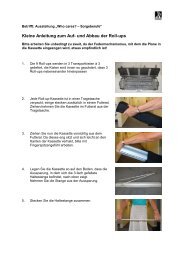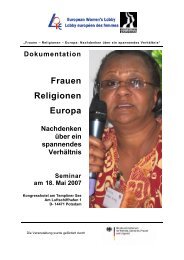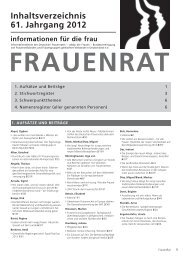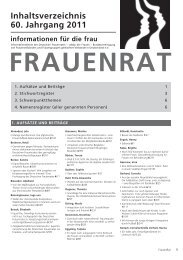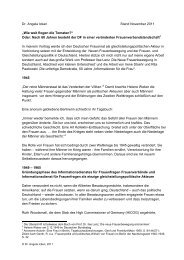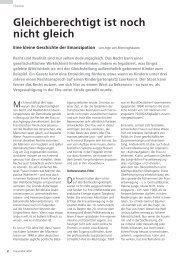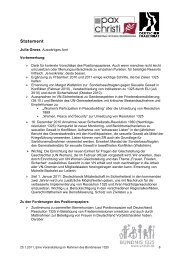Abpfiff - Deutscher Frauenrat
Abpfiff - Deutscher Frauenrat
Abpfiff - Deutscher Frauenrat
Erfolgreiche ePaper selbst erstellen
Machen Sie aus Ihren PDF Publikationen ein blätterbares Flipbook mit unserer einzigartigen Google optimierten e-Paper Software.
3<br />
“Inundated“ from the East Or: The chilling prospect of 40,000 prostitutes<br />
Picked out of a hat and subsequently continually referred to by the media, the<br />
figure of “ 0,000 prostitutes” and later “ 0,000 forced prostitutes” who would be<br />
brought to Germany on the occasion of the World Cup was not only completely<br />
unsubstantiated but also a persistent problem for the campaign. Although many<br />
experts repeatedly pointed out that this number has no basis in fact, it remained<br />
popular until the very end, and was even exaggerated by some media.<br />
The chilling prospect of 0,000 prostitutes led among other things to the<br />
phenomenon of especially foreign media, institutions and groups seizing on the<br />
prostitution legislation passed in Germany in 2002 and the existence of (large-scale)<br />
brothels and red-light districts as an opportunity to harp on the “sex industry”, to<br />
stigmatise prostitutes and to blame “liberal” regulations for the problem of forced<br />
prostitution.<br />
From the very beginning, the <strong>Deutscher</strong> <strong>Frauenrat</strong> (National Council of German<br />
Women’s Organizations) distanced itself from exaggerated, incorrect figures, and<br />
repeatedly emphasised that by their very nature, human trafficking and forced<br />
prostitution will have a large number of unreported cases and thus that the extent<br />
of the problem can be described at most by estimates, and certainly not by specific<br />
figures. Figures are also irrelevant, because if only a single woman were brought to<br />
Germany for the purpose of sexual exploitation, that would be a serious violation of<br />
human rights. One victim would be one too many.<br />
To legalise or not to legalise? Prostitution<br />
The Law on Regulating the Legal Status of Prostitutes (Gesetz zur Regelung der Rechtsverhältnisse<br />
von Prostituierten), or the Prostitution Law for short, went into effect in Germany in 2002. As the<br />
title of the law indicates, it regulates the legal claims between prostitutes and their clients as well<br />
as the provision of sex services within a labour framework including taxation and social benefits.<br />
The aim of the law is to counter existing legal discrimination against prostitutes, and to facilitate<br />
social benefits such as old-age pensions.<br />
The <strong>Deutscher</strong> <strong>Frauenrat</strong> had already resolved in 199 to work to ensure legal protection and<br />
social benefits for prostitutes, so the majority of its member organisations therefore welcomed the<br />
legislation.<br />
The initiators and network partners made every effort to ensure that the campaign issue, namely<br />
combating human trafficking for sexual exploitation, would not become caught up in a debate<br />
over legalising prostitution. But this could hardly be prevented. After all, there are political groups<br />
in Germany, including women’s organisations and initiatives, that reject or are critical of the<br />
Prostitution Law. Pressure from abroad is especially high, both from women’s and human rights’<br />
organisations that do not recognise any difference between voluntary and coerced prostitution<br />
and decry every form of commercial sex as coercion and violence, as well as from politicians of<br />
every stripe and colour who would like to prohibit prostitution for religious or gender-policy<br />
reasons. These positions were all loudly voiced.<br />
On the other flank, prostitutes’ groups in Germany entered the debate and complained that<br />
a discussion of forced prostitution automatically casts aspersions on legal prostitution and is<br />
therefore counterproductive to the aims of the Prostitution Law.<br />
One certainty is that the campaign focused attention not only on human trafficking for the purpose<br />
of sexual exploitation. It also introduced a new dynamic into the discussion, namely whether and<br />
under what conditions prostitution can be legalised to benefit prostitutes instead of clients and<br />
pimps. This debate needs to be pursued as soon as results from the assessment of the Prostitution<br />
Law are finally presented. These results are a necessary precondition for serious discussion.



